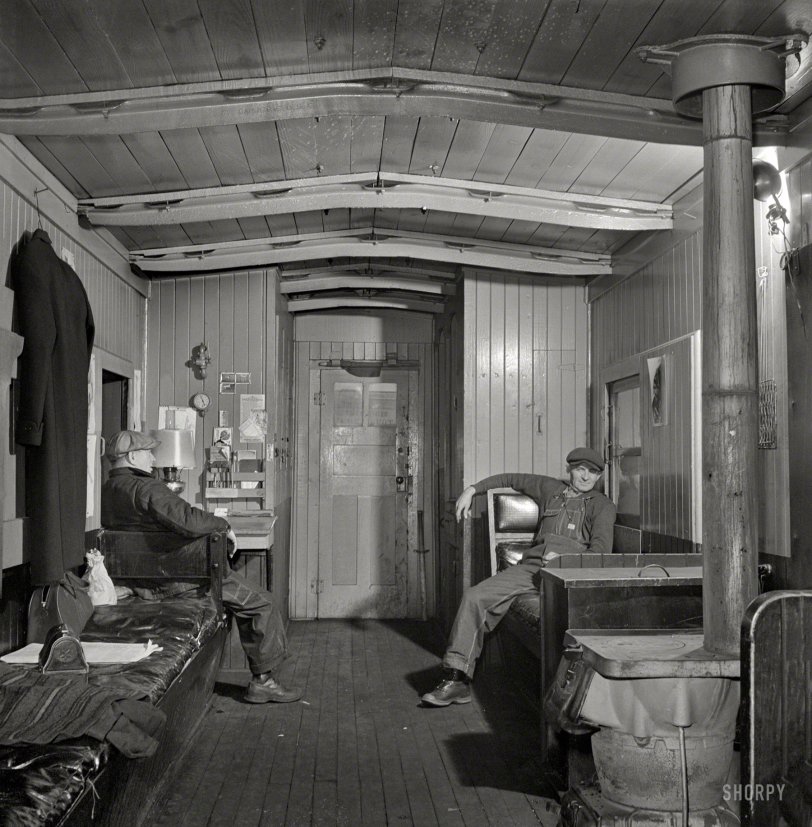


Framed or unframed, desk size to sofa size, printed by us in Arizona and Alabama since 2007. Explore now.
Shorpy is funded by you. Patreon contributors get an ad-free experience.
Learn more.

- Lost in Toyland
- And without gloves
- If I were a blindfolded time traveler
- Smoke Consumer Also Cooks
- Oh that stove!
- Possibly still there?
- What?!?
- $100 Reward
- Freeze Frame
- Texas Flyer wanted
- Just a Year Too Soon
- WWII -- Replacing men with women at the railroad crossing.
- Yes, Icing
- You kids drive me nuts!
- NOT An Easy Job
- I wonder
- Just add window boxes
- Icing Platform?
- Indiana Harbor Belt abides
- Freezing haze
- Corrections (for those who care)
- C&NW at Nelson
- Fallen Flags
- A dangerous job made worse
- Water Stop
- Passenger trains have right of way over freights?
- Coal
- Never ceases to amaze me.
- Still chuggin' (in model form)
- Great shot
Print Emporium
Belt Line Caboose: 1943

January 1943. "Freight operations on the Indiana Harbor Belt railroad between Chicago and Hammond, Indiana. Belt Line cabooses never go long distances or at very high speeds and are therefore constructed differently from line cabooses." Photo by Jack Delano for the Office of War Information. View full size.
Hunting Dog vs Pin Ups
It looks like the Conductor is more fond of his dog, than pin-up girls. One item on his desk rack is a Michigan Central employee timetable. Both the IHB and the MC were New York Central subsidiaries. Did anyone notice the "Carnegie" stamp on the roof beam?
A Brake Club
That "baseball bat" is a brake club. So named because the brakeman would use it for extra torque when applying the hand brake using the brake wheel. The "club" would be stuck through the spokes of the wheel and used for added leverage.
Of course, if an errant hobo were encountered --
Above the door is a red flag that the flagman would use to "protect" the rear of the train when stopped to flag down any following trains.
Brake Club
The stick next to the door is most likely a hickory brake club. There were many early freight cars and cabooses that still had mechanical brakes still in service during and after the war. During WWII they used anything with wheels. The brakeman would use it as a lever between the brake wheel spokes and shaft to tighten an lock the brakes. The brake wheel on top of the car was attached to a shaft that when rotated wound the chain under the car and connected to a bell crank that forced the brake shoes into the wheels. Before air brakes the brakeman would apply brakes of each car as the train was rolling according to steam whistle commands from the engineer. Many train museums have one of these on display.
Not a Bat
The "bat" by the door is a brake club, once used to apply extra leverage when applying or releasing hand brakes. I disclaim any suggestion that it also doubled as a defensive device.
Brake Stick
That's not a baseball bat, and security isn't its primary function, although it certainly could be used for that. It's a "brake stick." Inserted into the wheel of a hand brake, it makes tightening it down a lot easier. They were also used to release hand brakes, by hitting the ratchet that maintained tension on them. The tension on it was usually too strong for just a human hand. Hence the term, "knocking off" brakes.
The two ancient terms relating to hand brakes and brake sticks: "tie down" (set brakes), and "knock off" (release brakes) are still in widespread use on railroads today. You will hear them used in various permutations on the radio often.
Shoe rubbers
When you bought a pair of work shoes every 3 years, you dare not step in the muck without your rubbers on.
Recycle
I always thought it would be great to be able to have enough property to have a caboose behind the house someplace and make it into my artist's studio. Plenty of room for my needs, and I would add just enough amenities to make it livable. Alas, another dream never to be fulfilled.
Some prerequisite needs
A baseball bat next to the door for intruders and a calendar girl on the right wall.
Hidden in plain sight
I like the floodlight the photographer has cleverly hidden behind the stovepipe.
1940s Man-Cave
Now I realize what a man-cave looked like during World War II. No wonder little boys wanted to grow up to work for the railroad, all the live-long day.
Just a Dream
I'd sure like one of these to live in. My needs are simple but my romance
is great!
























On Shorpy:
Today’s Top 5